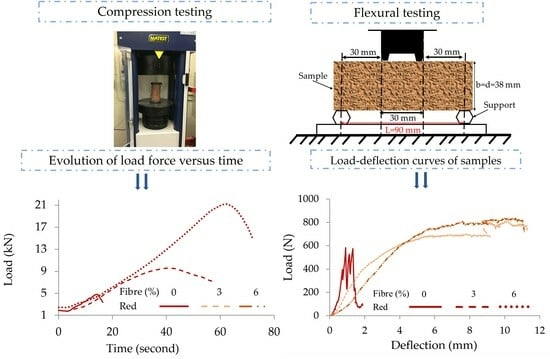The Impact of Vegetable Fibres on the Shrinkage and Mechanical Properties of Cob Materials
Abstract
:1. Introduction
2. Materials and Methods
2.1. Clay and Fibre Properties
2.2. Mineralogical Composition
2.3. Thermogravimetric Analysis (TGA/DTG)
2.4. Production of Test Samples
2.5. Volume Shrinkage Measurements
2.6. Mechanical Measurements
3. Results
3.1. Physical, Mineralogical, and Chemical Characterization
3.2. Thermal Thermogravimetric Analysis (TGA) and Differential Thermogravimetric Analysis (DTG)
3.3. Shrinkage Rates of Samples
3.4. Mechanical Properties
3.4.1. Compressive Strength
3.4.2. Flexural Strength
3.5. The Use of the Studied Cob in Construction
- To moisten the fibres, spread them out on a tarpaulin on the ground and dampen the whole (205% W/F), leaving it until the clay/water mixture is ready.
- To mix clay and water, spread the clay on a tarpaulin or in the mixer, pour the required amount of water onto the surface of the clay (25% W/C), and mix until homogeneous.
- For mixes without a mixer, use shovels to bring all the cob together and remix to obtain a homogeneous consistency.
- At the end of mixing, leave to stand for half a day, then spread the wet fibres over the surface of the clay/water mixture and remix to obtain a homogeneous mixture, a consistency that can be used to fill the wooden frame.
4. Conclusions
- An analysis of the drying kinetics showed that the addition of fibres to the clay mix reduces the volume shrinkage rate of clay materials while eliminating cracking, but the extent depends wholly on how the fibres are used (dry or wet).
- To eliminate surface cracking, the fibres must be wetted with a suitable quantity of water for 10 to 24 h before mixing. Moreover, the addition of the fibres reduces the density of the cob materials, thus reducing the weight of the cob structures.
- An analysis of the results of the mechanical strength of the samples showed that the reinforcement with wheat fibres improves the mechanical properties, although the samples were manually made with bulk fibres.
- The samples reinforced with wheat fibres have a plastic behaviour enabling walls constructed with these materials to withstand environmental stresses such as earthquakes and strong winds without collapsing.
- An ANOVA and t-test analysis revealed significant values, showing that at 28 days of drying, the samples without fibres exhibited higher flexural strength than those with fibres. However, at 120 days of drying, the flexural strength values of the samples with fibres improved to match those of the samples without fibres, indicating a progressive enhancement in the flexural strength of the fibre-reinforced samples over time.
- Experimental studies on cob specimens manufactured with different types of plant fibres need to be developed using the same manufacturing method.
- There should be a study of the influence of water content on the mechanical properties and volumetric shrinkage of cob to observe the influence of varying water content on the compressive and flexural strength of cob specimens manufactured using the traditional method.
- Modelling the volume shrinkage of the cob with 3% and 6% fibres as a function of time is important, using real climatic data to observe how cob reacts when the climate varies.
- Studying the behaviour of cob walls in the face of earthquakes and high winds (vertical/horizontal/diagonal wood-frame systems filled with cob) is also important. A study on the cost savings of this type of construction compared to conventional material construction would be necessary to confirm all the benefits associated with cob construction.
Supplementary Materials
Author Contributions
Funding
Institutional Review Board Statement
Informed Consent Statement
Data Availability Statement
Acknowledgments
Conflicts of Interest
References
- Aymerich, F.; Fenu, F.; Francesconi, L.; Meloni, P. Fracture behaviour of a fibre reinforced earthen material under static and impact flexural loading. Constr. Build. Mater. 2016, 109, 109–119. [Google Scholar] [CrossRef]
- Ramakrishna, S.; Pervaiz, M.; Tjong, J.; Ghisellini, P.; Sain, M.M. Low-carbon materials: Genesis, thoughts, case study, and perspectives. Circ. Econ. Sustain. 2021, 2, 649–664. [Google Scholar] [CrossRef]
- Ruiz, G.; Zhang, X.; Edris, W.F.; Cañas, I.; Garijo, L. A comprehensive study of mechanical properties of compressed earth blocks. Constr. Build. Mater. 2018, 176, 566–572. [Google Scholar] [CrossRef]
- Reddy, B.V.; Leuzinger, G.; Sreeram, V. Low embodied energy cement stabilised rammed earth building—A case study. Energy Build. 2014, 68, 541–546. [Google Scholar] [CrossRef]
- Azil, A.; Le Guern, M.; Touati, K.; Sebaibi, N.; Boutouil, M.; Streiff, F.; Gomina, M. Earth construction: Field variabilities and laboratory reproducibility. Constr. Build. Mater. 2022, 314, 125591. [Google Scholar] [CrossRef]
- Giuffrida, G.; Caponetto, R.; Cuomo, M. An overview on contemporary rammed earth buildings: Technological advances in production, construction and material characterization. In IOP Conference Series: Earth and Environmental Science; IOP Publishing: Milan, Italy, 2019. [Google Scholar] [CrossRef]
- Avila, F.; Puertas, E.; Gallego, R. Characterization of the mechanical and physical properties of unstabilized rammed earth: A review. Constr. Build. Mater. 2021, 270, 121435. [Google Scholar] [CrossRef]
- Teixeira, E.R.; Machado, G.; Junior, A.D.; Guarnier, C.; Fernandes, J.; Silva, S.M.; Mateus, R. Mechanical and thermal performance characterisation of compressed earth blocks. Energies 2020, 13, 2978. [Google Scholar] [CrossRef]
- Rafi, M.M.; Lodi, S.H. Comparison of dynamic behaviours of retrofitted and unretrofitted cob material walls. Bull. Earthq. Eng. 2017, 15, 3855–3869. [Google Scholar] [CrossRef]
- Miccoli, L.; Müller, U.; Fontana, P. Mechanical behaviour of earthen materials: A comparison between earth block masonry, rammed earth and cob. Constr. Build. Mater. 2014, 61, 327–339. [Google Scholar] [CrossRef]
- Quagliarini, E.; Maracchini, G. Experimental and FEM investigation of cob walls under compression. Adv. Civ. Eng. 2018, 2018, 7027432. [Google Scholar] [CrossRef]
- Sen, B.; Saha, R. Experimental and numerical investigation of mechanical strength characteristics of natural fiber retrofitted rammed earth walls. Geotext. Geomembr. 2022, 50, 970–993. [Google Scholar] [CrossRef]
- Paquet, L. Enhancing Mechanical Properties of CEB (Compressed Earth Blocks) with Natural Fibres. Ph.D. Thesis, Université Libre de Bruxelles, Bruxelles, Belgium, 2020. [Google Scholar]
- RB299-19_IRC, 2018 International Residential Code: APPENDIX U Cob Construction (Monolithic Adobe). ICC COMMITTEE ACTION HEARINGS 2019, 36. Available online: https://cobcode.s3.amazonaws.com/RB299-19_IRC_ProposedAppendixU_CobConstruction.pdf (accessed on 25 January 2024).
- Sangma, S.; Tripura, D.D. Experimental study on shrinkage behaviour of earth walling materials with fibers and stabilizer for cob building. Constr. Build. Mater. 2020, 256, 119449. [Google Scholar] [CrossRef]
- Hamard, E.; Cazacliu, B.; Razakamanantsoa, A.; Morel, J.C. Cob, a vernacular earth construction process in the context of modern sustainable building. Build. Environ. 2016, 106, 103–119. [Google Scholar] [CrossRef]
- Wang, J.; Zhao, H. High performance damage-resistant seismic resistant structural systems for sustainable and resilient city: A review. Shock. Vib. 2018, 2018, 8703697. [Google Scholar] [CrossRef]
- Meng, B.; Xiong, Y.; Zhong, W.; Duan, S.; Li, H. Progressive collapse behaviour of composite substructure with large rectangular beam-web openings. Eng. Struct. 2023, 295, 116861. [Google Scholar] [CrossRef]
- Tomovska, R.; Radivojević, A. Tracing sustainable design strategies in the example of the traditional Ohrid house. J. Clean. Prod. 2017, 147, 10–24. [Google Scholar] [CrossRef]
- Makaka, G.; Meyer, E. Temperature stability of traditional and low-cost modern housing in the Eastern Cape, South Africa. J. Build. Phys. 2006, 30, 71–86. [Google Scholar] [CrossRef]
- Wafer, R.-P. L’adobe, une Solution Durable Pour la Construction d’Habitations Ecologiques Dans une Zone à Forte Activité Sismique Comme le Chili; Université de Sherbrooke: Sherbrooke, QC, Canada, 2010. [Google Scholar]
- Cuitiño, G.; Maldonado, G.; Esteves, A. Analysis of the Mechanical Behavior of Prefabricated Wattle and Daub Walls. Int. J. Archit. Eng. Constr. 2014, 3, 235–246. [Google Scholar] [CrossRef]
- Huang, H.; Wu, Y.; Li, Z.; Sun, Z.; Chen, Z. Seismic behavior of Chuan-Dou type timber frames. Eng. Struct. 2018, 167, 725–739. [Google Scholar] [CrossRef]
- Rafi, M.M.; Lodi, S.H.; Qazi, S.A. Dynamic testing of seismic resistant cob structure for post-earthquake reconstruction. J. Earthq. Eng. 2021, 25, 1009–1030. [Google Scholar] [CrossRef]
- Sangma, S.; Tripura, D.D. Flexural strength of cob wallettes reinforced with bamboo and steel mesh. Constr. Build. Mater. 2021, 272, 121662. [Google Scholar] [CrossRef]
- Bothara, J.; Ingham, J.; Dizhur, D. Qualifying the earthquake resilience of vernacular masonry buildings along the Himalayan arc. J. Build. Eng. 2022, 52, 104339. [Google Scholar] [CrossRef]
- Rios, A.J.; O’Dwyer, D. Experimental validation for the application of the flat jack test in cob walls. Constr. Build. Mater. 2020, 254, 119148. [Google Scholar] [CrossRef]
- Chinnasamy, Y.; Joanna, P.S.; Kothanda, K.; Gurupatham, B.G.A.; Roy, K. Behavior of Pultruded Glass-Fiber-Reinforced Polymer Beam-Columns Infilled with Engineered Cementitious Composites under Cyclic Loading. J. Compos. Sci. 2022, 6, 338. [Google Scholar] [CrossRef]
- Pan, Y.; Ventura, C.E.; Tannert, T. Damage index fragility assessment of low-rise light-frame wood buildings under long duration subduction earthquakes. Struct. Saf. 2020, 84, 101940. [Google Scholar] [CrossRef]
- Millogo, Y.; Morel, J.C.; Aubert, J.E.; Ghavami, K. Experimental analysis of Pressed Adobe Blocks reinforced with Hibiscus cannabinus fibers. Constr. Build. Mater. 2014, 52, 71–78. [Google Scholar] [CrossRef]
- Makomra, V.; Tapsia, L.K.; Ndiwe, B.; Kaoutoing, M.D.; Konai, N.; Njom, A.; Laynde, T.; Raidandi, D. Physico-Mechanical Properties of Bio-Based Bricks. J. Mater. Sci. Chem. Eng. 2022, 10, 16–29. [Google Scholar] [CrossRef]
- Toguyeni, D.Y.; Lawane, A.; Zoma, F.; Khamis, G. Formulation of Compressed Earth Blocks Stabilized with Lime and Hibiscus sabdariffa Fibres Showcasing Good Thermal and Mechanical Properties. J. Mater. Sci. Surf. Eng. (JMSSE) 2018, 6, 817–824. [Google Scholar]
- Lertwattanaruk, P.; Choksiriwanna, J. The physical and thermal properties of adobe brick containing bagasse for earth construction. Int. J. Build. Urban Inter. Landsc. Technol. (BUILT) 2011, 1, 57–66. [Google Scholar] [CrossRef]
- Giroudon, M.; Laborel-Préneron, A.; Aubert, J.E.; Magniont, C. Comparison of barley and lavender straws as bioaggregates in earth bricks. Constr. Build. Mater. 2019, 202, 254–265. [Google Scholar] [CrossRef]
- Bouhicha, M.; Aouissi, F.; Kenai, S. Performance of composite soil reinforced with barley straw. Cem. Concr. Compos. 2005, 27, 617–621. [Google Scholar] [CrossRef]
- Dubois, S.; Lebeau, F. Impact des matériaux biosourcés sur le climat intérieur: Un outil de calcul flexible à l’échelle de la pièce. Ecobat Sci. Tech. 2014, 11. Available online: https://hdl.handle.net/2268/164979 (accessed on 18 January 2024).
- Přikryl, R.; Török, Á.; Theodoridou, M.; Gomez-Heras, M.; Miskovsky, K. Geomaterials in construction and their sustainability: Understanding their role in modern society. Spec. Publ. 2016, 416, 1–22. [Google Scholar] [CrossRef]
- Belabid, A.; Akhzouz, H.; Elminor, H.; Elminor, H. Characteristics of traditional building materials and techniques based on earth, stone and timber: An overview and focus on Morocco. J. Eng. 2023, 10, 1–15. [Google Scholar]
- Claudiane, O.-P.; Aguerata, K. Hygrothermal Measurement of Heavy Cob Materials; Springer: Cham, Switzerland, 2023. [Google Scholar] [CrossRef]
- Kaboré, A.; Ouellet-Plamondon, C. Characterization of the clay and fibres for hygrothermal modelling. In Canadian Society of Civil Engineering Annual Conference; Springer: Berlin/Heidelberg, Germany, 2021. [Google Scholar] [CrossRef]
- ASTM D854-14, A; Standard Test Methods for Specific Gravity of Soil Solids by Water Pycnomete. ASTM International: West Conshohocken, PA, USA, 2014. Available online: https://compass.astm.org/document/?contentCode=ASTM%7CD0854-14%7Cen-US (accessed on 16 February 2023).
- ASTM D2654-89a, A; Standard Test Method for Moisture in Textile. ASTM: West Conshohocken, PA, USA, 1989. Available online: https://global.ihs.com/doc_detail.cfm?document_name=ASTM%20D2654&item_s_key=00016807 (accessed on 16 February 2023).
- Bunaciu, A.A.; UdriŞTioiu, E.G.; Aboul-Enein, H.Y. X-ray diffraction: Instrumentation and applications. Crit. Rev. Anal. Chem. 2015, 45, 289–299. [Google Scholar] [CrossRef]
- Epp, J. X-ray diffraction (XRD) techniques for materials characterization. In Materials Characterization Using Nondestructive Evaluation (NDE) Methods; Elsevier: Bremen, Germany, 2016; pp. 81–124. [Google Scholar] [CrossRef]
- Ameh, E. A review of basic crystallography and x-ray diffraction applications. Int. J. Adv. Manuf. Technol. 2019, 105, 3289–3302. [Google Scholar] [CrossRef]
- Volhard, F. Light earth building. In Light Earth Building; Birkhäuser: Basel, Switzerland, 2016. [Google Scholar]
- ASTM C157/C157M-17; Standard Test Method for Length Change of Hardened Hydraulic-Cement Mortar and Concrete. ASTM International: West Conshohocken, PA, USA, 2017. Available online: www.astm.org (accessed on 20 March 2023).
- ASTM C39/C39M; Standard Test Method for Compressive Strength of Cylindrical Concrete Specimens. ASTM International: West Conshohocken, PA, USA, 2020. Available online: https://compass.astm.org/document/?contentCode=ASTM%7CC0039_C0039M-20%7Cen-US (accessed on 21 March 2023).
- ASTM C78/C78M; Standard Test Method for Flexural Strength of Concrete (Using Simple Beam with Third-Point Loading). In American Society for Testing and Materials. ASTM International: West Conshohocken, PA, USA, 2021. Available online: https://compass.astm.org/document/?contentCode=ASTM%7CC0078_C0078M-22%7Cen-US (accessed on 21 March 2023).
- Kagonbé, B.P.; Tsozué, D.; Nzeukou, A.N.; Ngos III, S. Mineralogical, Geochemical and Physico-Chemical Characterization of Clay Raw Materials from Three Clay Deposits in Northern Cameroon. J. Geosci. Environ. Prot. 2021, 9, 86–99. [Google Scholar] [CrossRef]
- Arianpour, A.Ç.; Arianpour, F. Characterization, technological properties, and ceramic applications of Kastamonu alluvial clays (Northern Turkey) in building materials. Constr. Build. Mater. 2022, 356, 129304. [Google Scholar] [CrossRef]
- Acevedo, N.; Rocha, M.; Bertolino, L. Mineralogical characterization of natural clays from Brazilian Southeast region for industrial applications. Cerâmica 2017, 63, 253–262. [Google Scholar] [CrossRef]
- Tsozué, D.; Nzeugang, A.N.; Mache, J.R.; Loweh, S.; Fagel, N. Mineralogical, physico-chemical and technological characterization of clays from Maroua (Far-North, Cameroon) for use in ceramic bricks production. J. Build. Eng. 2017, 11, 17–24. [Google Scholar] [CrossRef]
- Fabbri, A.; Morel, J.C.; Aubert, J.E.; Bui, Q.B.; Gallipoli, D.; Reddy, B.V. Testing and Characterisation of Earth-Based Building Materials and Elements: State-of-the-Art Report of the RILEM TC 274-TCE. 2021. Available online: https://link.springer.com/content/pdf/10.1007/978-3-030-83297-1.pdf (accessed on 9 November 2023).
- Tsozué, D.; Nzeukou, A.N.; Kogonbé, B.P.; Madi, A.B.; Mache, J.R.; Bitom, D.L.; Fagel, N. Genesis and assessment of clay materials suitability for earthenware production in northern Cameroon. Arab. J. Geosci. 2022, 15, 1376. [Google Scholar] [CrossRef]
- Farouk, S.; El-Desoky, H.; Heikal, M.; El-Mahallawy, M.; Wahid, A. Egyptian Cretaceous clay deposits: Insights on Mineralogy, Geochemistry, and Industrial uses. Arab. J. Geosci. 2020, 13, 556. [Google Scholar] [CrossRef]
- Vivek, S.; Kanthavel, K. Effect of bagasse ash filled epoxy composites reinforced with hybrid plant fibres for mechanical and thermal properties. Compos. Part B Eng. 2019, 160, 170–176. [Google Scholar] [CrossRef]
- Mohana Krishnudu, D.; Sreeramulu, D.; Reddy, P.V. Alkali treatment effect: Mechanical, thermal, morphological, and spectroscopy studies on abutilon indicum fiber-reinforced composites. J. Nat. Fibers 2020, 17, 1775–1784. [Google Scholar] [CrossRef]
- Sarikanat, M.; Seki, Y.; Sever, K.; Durmuşkahya, C. Determination of properties of Althaea officinalis L.(Marshmallow) fibres as a potential plant fibre in polymeric composite materials. Compos. Part B Eng. 2014, 57, 180–186. [Google Scholar] [CrossRef]
- Alwani, M.S.; Khalil, H.A.; Sulaiman, O.; Islam, M.N.; Dungani, R. An approach to using agricultural waste fibres in biocomposites application: Thermogravimetric analysis and activation energy study. BioResources 2013, 9, 218–230. [Google Scholar] [CrossRef]
- Ige, O.; Danso, H. Physico-mechanical and thermal gravimetric analysis of adobe masonry units reinforced with plantain pseudo-stem fibres for sustainable construction. Constr. Build. Mater. 2021, 273, 121686. [Google Scholar] [CrossRef]
- Mayandi, K.; Rajini, N.; Pitchipoo, P.; Sreenivasan, V.S.; Jappes, J.W.; Alavudeen, A. A comparative study on characterisations of Cissus quadrangularis and Phoenix reclinata natural fibres. J. Reinf. Plast. Compos. 2015, 34, 269–280. [Google Scholar] [CrossRef]
- Gandia, R.M.; Gomes, F.C.; Corrêa, A.A.R.; Rodrigues, M.C.; Mendes, R.F. Physical, mechanical and thermal behavior of adobe stabilized with glass fiber reinforced polymer waste. Constr. Build. Mater. 2019, 222, 168–182. [Google Scholar] [CrossRef]
- Charai, M.; Mezrhab, A.; Moga, L. A structural wall incorporating biosourced earth for summer thermal comfort improvement: Hygrothermal characterization and building simulation using calibrated PMV-PPD model. Build. Environ. 2022, 212, 108842. [Google Scholar] [CrossRef]
- Laou, L. Evaluation du Comportement Mécanique Sous Sollicitations Thermohydriques d’un Mur Multimatériaux (Bois, Terre Crue, Liants Minéraux) Lors de sa Construction et de Son Utilisation. Ph.D. Thesis, Université de Limoges, Limoges, France, 2017. [Google Scholar]
- Araya-Letelier, G.; Concha-Riedel, J.; Antico, F.C.; Sandoval, C. Experimental mechanical-damage assessment of earthen mixes reinforced with micro polypropylene fibers. Constr. Build. Mater. 2019, 198, 762–776. [Google Scholar] [CrossRef]
- Raymond, G.E.; Mabiala, B.; Ahouet, L.; Goma-Maniongui, J.; Dirras, G.F. Characterization of clayey soils from congo and physical properties of their compressed earth blocks reinforced with post-consumer plastic wastes. Geomaterials 2011, 2011, 8177. Available online: http://www.scirp.org/journal/PaperInformation.aspx?PaperID=8177 (accessed on 25 January 2024).
- Wang, Q.; Chen, T.; Wang, X.; Zheng, Y.; Zheng, J.; Song, G.; Liu, S. Recent Progress on Moisture Absorption Aging of Plant Fiber Reinforced Polymer Composites. Polymers 2023, 15, 4121. [Google Scholar] [CrossRef] [PubMed]
- Bui, Q.B.; Morel, J.C.; Hans, S.; Walker, P. Effect of moisture content on the mechanical characteristics of rammed earth. Constr. Build. Mater. 2014, 54, 163–169. [Google Scholar] [CrossRef]
- Kumar, A.; Walia, B.S.; Mohan, J. Compressive strength of fiber reinforced highly compressible clay. Constr. Build. Mater. 2006, 20, 1063–1068. [Google Scholar] [CrossRef]
- Laibi, A.B.; Poullain, P.; Leklou, N.; Gomina, M.; Sohounhloué, D.K. Influence of the kenaf fiber length on the mechanical and thermal properties of Compressed Earth Blocks (CEB). KSCE J. Civ. Eng. 2018, 22, 785–793. [Google Scholar] [CrossRef]
- Chegenizadeh, A.; Nikraz, H. Investigation on strength of fiber reinforced clay. Adv. Mater. Res. 2011, 261, 957–963. [Google Scholar] [CrossRef]
- Rode, C.; Peuhkuri, R.H.; Mortensen, L.H.; Hansen, K.K.; Time, B.; Gustavsen, A.; Ojanen, T.; Ahonen, J.; Svennberg, K.; Arfvidsson, J.; et al. Moisture Buffering of Building Materials; Technical University of Denmark, Department of Civil Engineering: Lyngby, Denmark, 2005; Available online: https://vbn.aau.dk/ws/files/235442745/byg-r126.pdf (accessed on 18 November 2023).
- Brick, C. Use of Vegetable Fibers as Reinforcement in the Structure of Compressed Ground Bricks: Influence of Sawdust on the Rheological Properties of Compressed. Am. J. Mater. Sci. Eng. 2016, 4, 13–19. Available online: https://citeseerx.ist.psu.edu/viewdoc/download?doi=10.1.1.1057.3575&rep=rep1&type=pdf (accessed on 22 October 2023).

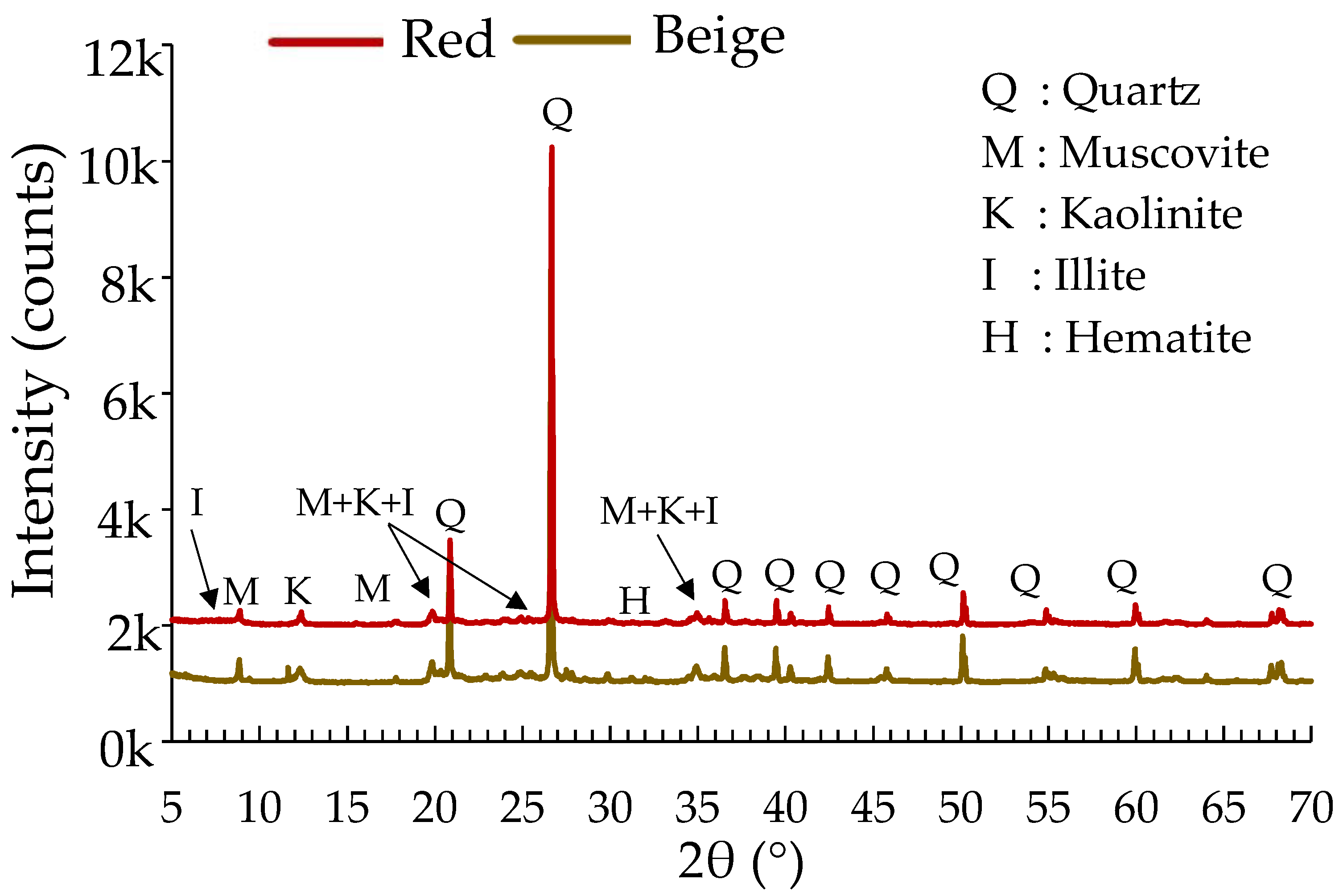

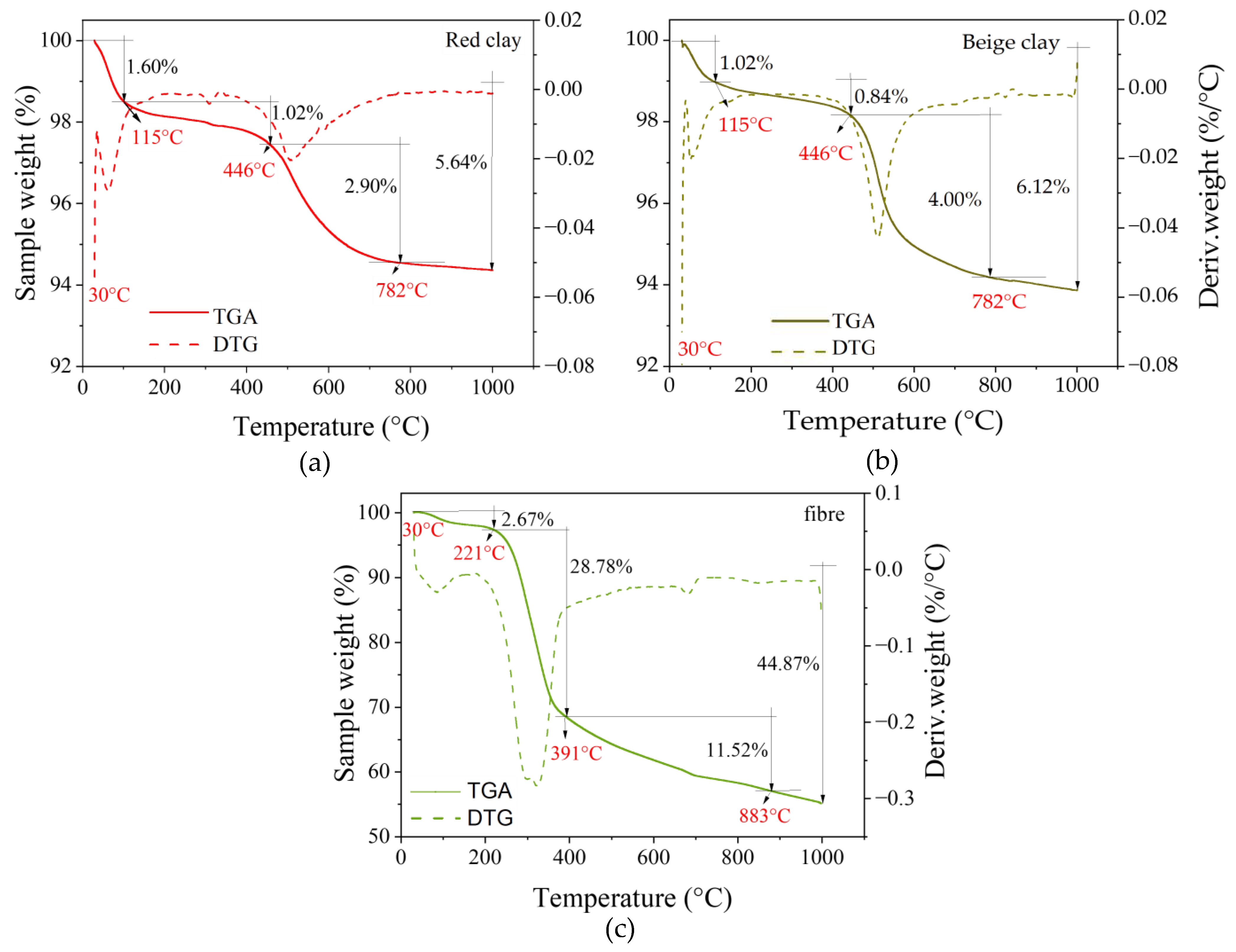
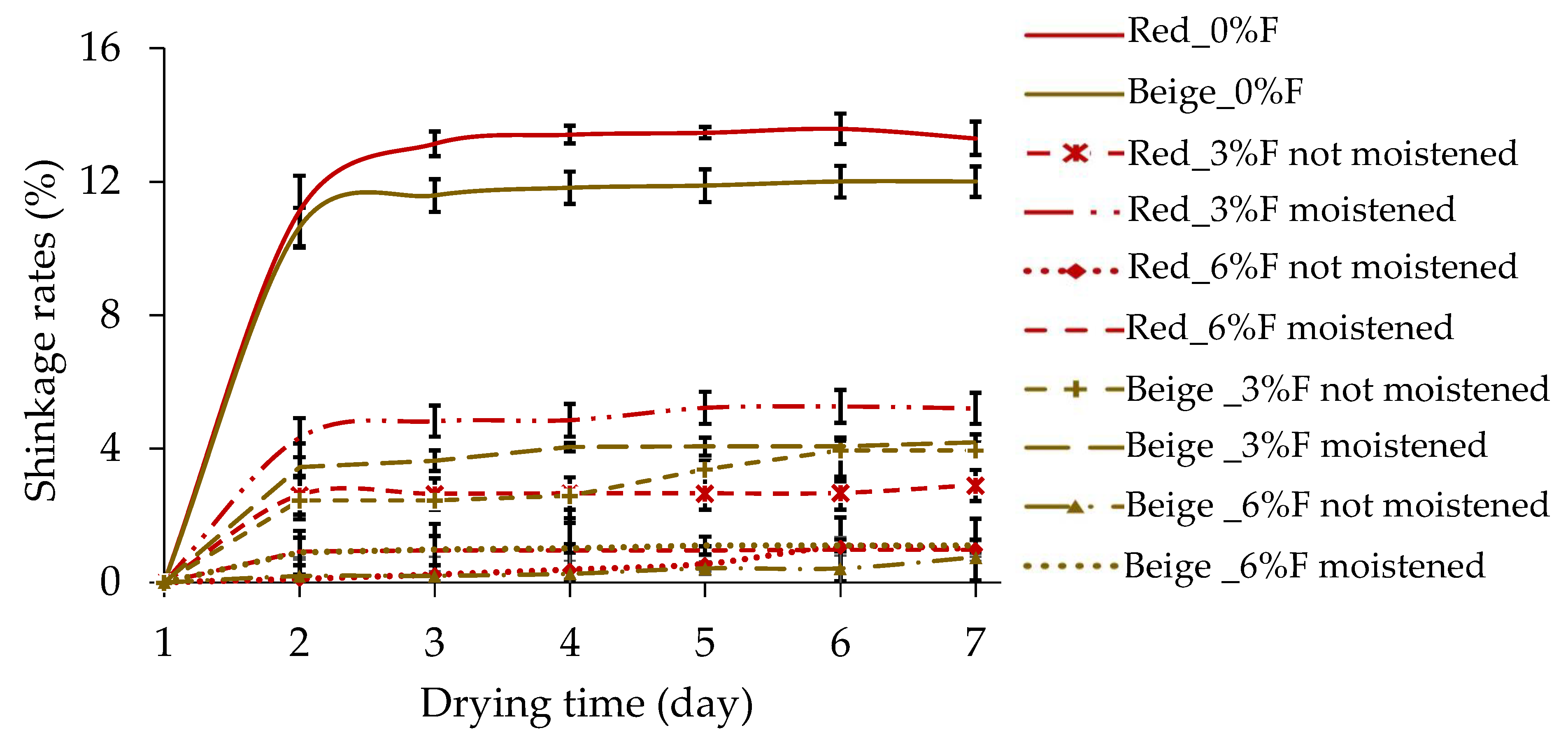
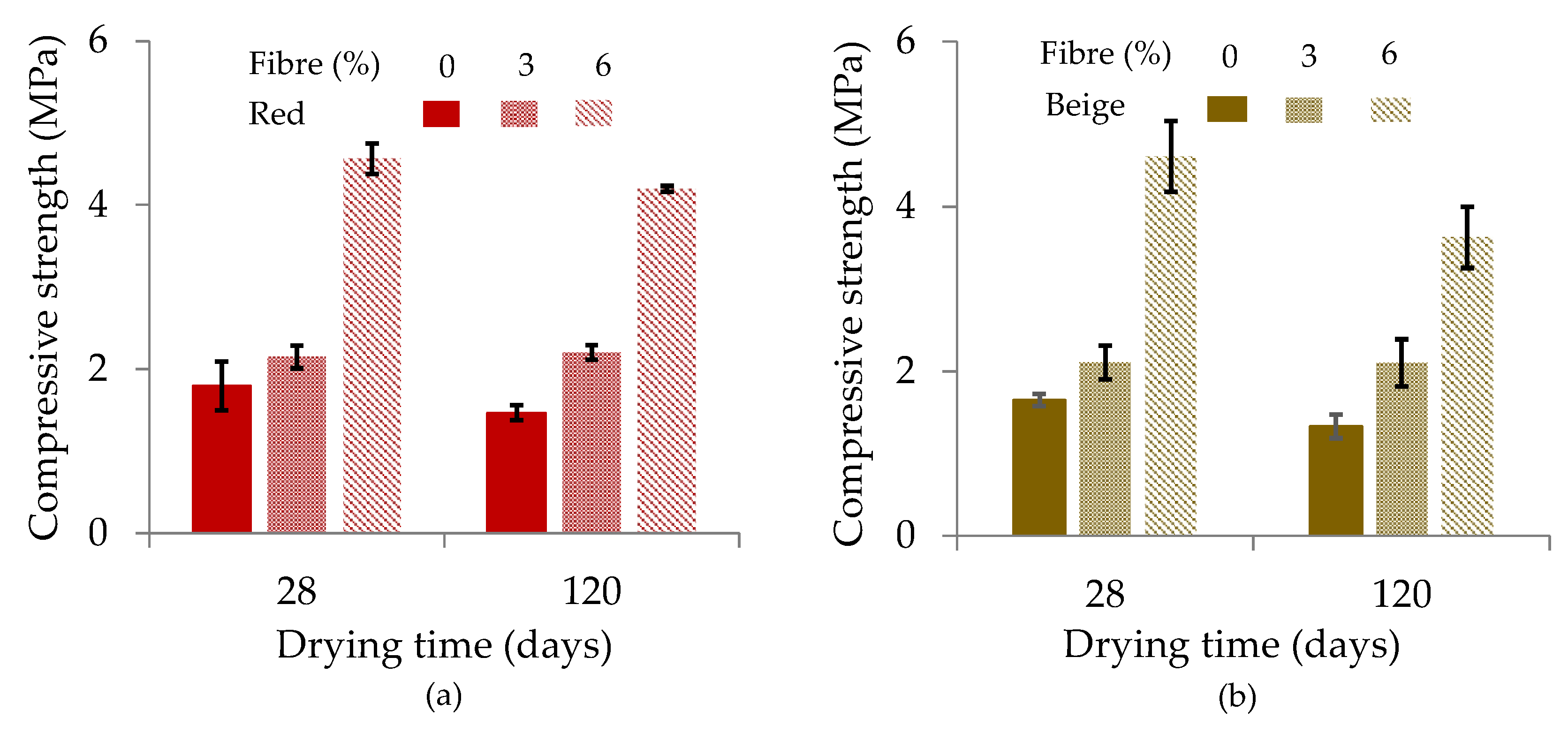
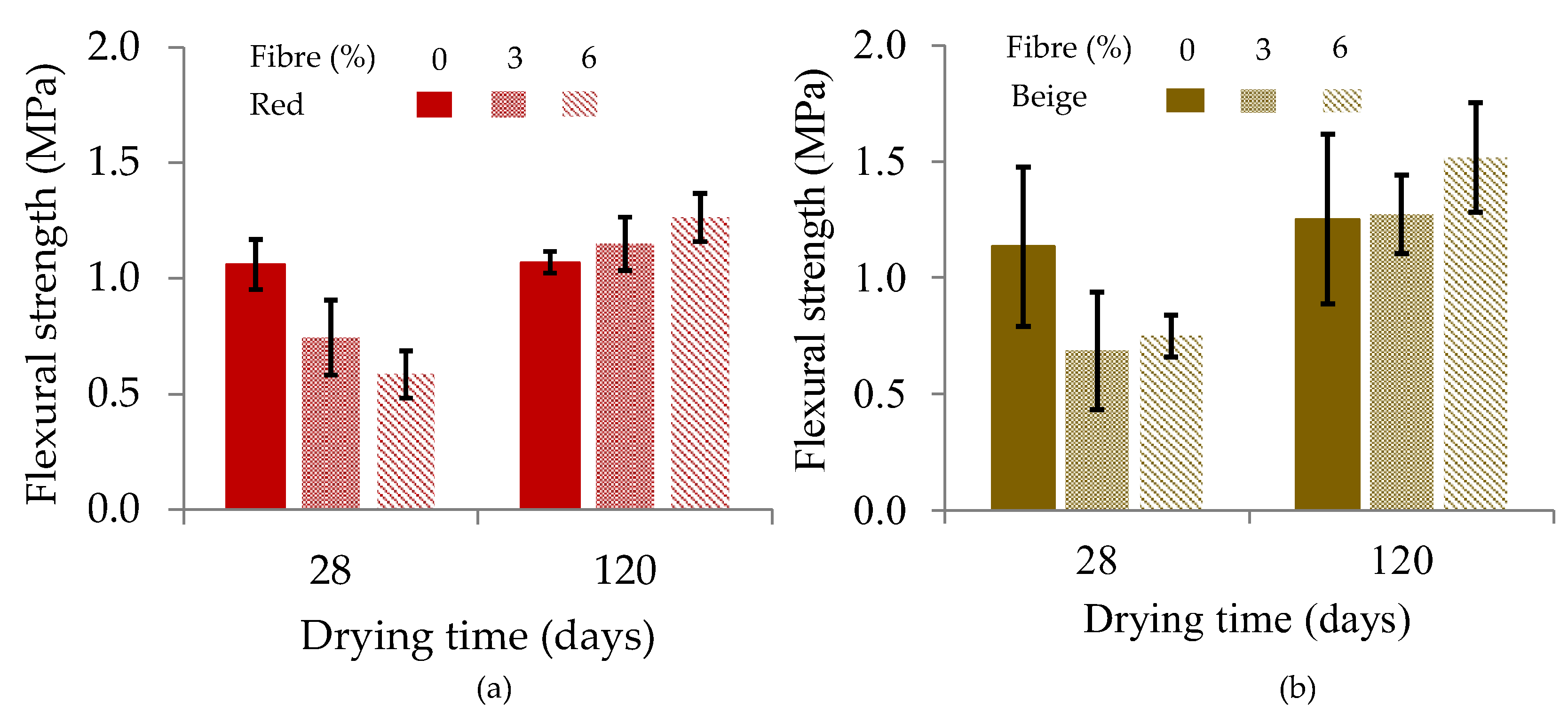
| Fibre Content (%) (Fibre/Clay) | Clay Mass | Water Mass (Water/Clay = 25%) | Mass of Wheat Fibre | Mass of Water for Wheat Humidification Water/Fibre = 205% |
|---|---|---|---|---|
| 0 | 5000 | 1250 | 0 | 0 |
| 3 | 4850 | 1212.5 | 150 | 307.5 |
| 6 | 4700 | 1175 | 300 | 615 |
| Steps | Description | Step Duration |
|---|---|---|
| 1 | Fibre humidification | 1 to 2 h |
| 2 | Mixture of clay and water | Approx. 15 min |
| 3 | Addition of fibre: mixing clay, water, and humidified fibres to obtain a homogenous mixture | Approx. 15 to 20 min |
| 4 | Total mixture rest time | 2 to 3 h |
| Mineralogical Compositions (Weight %) | |||||
|---|---|---|---|---|---|
| Type of Clay | Kaolinite | Quartz (Silicates) | Illite | Muscovite (Mica) | Hematite |
| Red | 8.9 | 42.6 | 21.8 | 24.5 | 2.2 |
| Beige | 25.8 | 42.5 | 14.6 | 16.9 | 0.1 |
| Chemical Compositions (Weight %) | |||||
|---|---|---|---|---|---|
| H2O | MgO | Al2O3 | SiO2 | K2O | |
| Red | 2.4 | 0.8 | 19.9 | 70.1 | 4.7 |
| Beige | 4.4 | 0.5 | 21.3 | 70.4 | 3.2 |
Disclaimer/Publisher’s Note: The statements, opinions and data contained in all publications are solely those of the individual author(s) and contributor(s) and not of MDPI and/or the editor(s). MDPI and/or the editor(s) disclaim responsibility for any injury to people or property resulting from any ideas, methods, instructions or products referred to in the content. |
© 2024 by the authors. Licensee MDPI, Basel, Switzerland. This article is an open access article distributed under the terms and conditions of the Creative Commons Attribution (CC BY) license (https://creativecommons.org/licenses/by/4.0/).
Share and Cite
Kabore, A.; Ouellet-Plamondon, C.M. The Impact of Vegetable Fibres on the Shrinkage and Mechanical Properties of Cob Materials. Materials 2024, 17, 736. https://doi.org/10.3390/ma17030736
Kabore A, Ouellet-Plamondon CM. The Impact of Vegetable Fibres on the Shrinkage and Mechanical Properties of Cob Materials. Materials. 2024; 17(3):736. https://doi.org/10.3390/ma17030736
Chicago/Turabian StyleKabore, Aguerata, and Claudiane M. Ouellet-Plamondon. 2024. "The Impact of Vegetable Fibres on the Shrinkage and Mechanical Properties of Cob Materials" Materials 17, no. 3: 736. https://doi.org/10.3390/ma17030736






